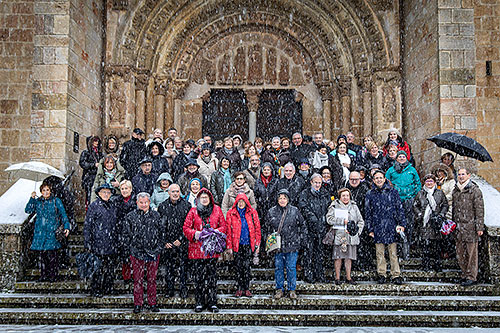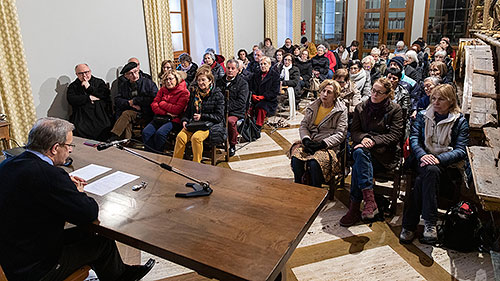Juan Manuel Apesteguía, Abbot of the Monastery of Leire
Clara Fernández-Ladreda, Professor at the University of Navarra, Spain
Luis Javier Fortún, Corresponding Member of the Spanish Academy of History
Leire, el monasterio de Navarra<br><br>16 de noviembre de 2019
:
PHOTO: J. Caso DN
MONKS, YESTERDAY AND TODAY
Juan Manuel Apesteguía
Abbot of the monastery of Leire
Saint Benedict, father of the monks of the West, was born in Nursia (Italy) in 480 and died in the monastery of Montecasino (Italy) in 547. As a young man he withdrew to solitude "desiring to please God alone". His charism and holiness soon made him a renowned abbot of monks. For them he wrote his famous Rule that would reach an extraordinary diffusion throughout the European West and would contribute decisively to form the European culture and the Western civilization.
The numerous Benedictine family, followers of St. Benedict and his Rule, currently has many branches, among which the Benedictines and the Cistercians stand out. The Benedictine monks, considered as the most direct disciples of Saint Benedict, live in autonomous monasteries that are associated among them, integrating the Order of Saint Benedict. In Navarre we have one Benedictine monastery for men (San Salvador de Leire) and another Cistercian monastery (La OLiva). In addition, there are four other female monasteries: two of Benedictine nuns (in Alzuza and Estrella) and two of Cistercian nuns (in Tulebras and Alloz).
The life of a Benedictine monk is centered on the search for God through prayer and work: Ora et labora. The monastic workshop is articulated between three complementary activities: the communal celebration of the liturgy, the work and the lectio divina (a prayerful reading of the Sacred Scripture or the Fathers or other classics of Christian spirituality). In addition, monasticism has cultivated study over the centuries, giving rise to the training of great libraries and schools that in the early Middle Ages saved the Greco-Roman and Christian culture and served as a foundation for the creation of a new European culture.
The celebration of the liturgy has its center in the solemn celebration of the Holy Mass and includes the so-called "Hours" of the "official document Divino" that mark the workshop of the monk: Matins Vigil (at the end of the night), Lauds (at the beginning of the morning), Terce, Sext and Nona (along the workshop), Vespers (at dusk) and Compline (at the end of the workshop). As a whole, the alternation between times of prayer, of work, of lectio divina and of study, favors a balanced life of the monk, who sees his day pass peacefully under the gaze of God, to whom he offers with love all that he does.

PHOTO: J. Case DN
LEIRE, CRADLE OF THE ROMANESQUE STYLE IN NAVARRE
Clara Fernández-Ladreda Aguadé
University of Navarra
The church of Leire that we see today is the result of three construction phases: two corresponding to the Romanesque and the third to the late Gothic.
The one that has attracted the most attention is the first one, to which the crypt and the chevet of the upper church belong. Their importance lies in the fact that they constitute the oldest manifestation of Romanesque art not only in Navarre but in the entire western half of the peninsula. They were conceived as an extension to the east of an earlier pre-Romanesque temple. The initiative of its construction is attributed to King Sancho III the Greater and it seems that the process may have begun around 1020 and concluded in 1057 with the solemn consecration, presided over by Sancho of Peñalén. The works were directed by an anonymous master, who did not mind facing new challenges, which he tried to solve by applying solutions of various origins -ultrapyrenean and Hispanic-, showing his creative capacity, although not always the result is perfect.
The second phase is less relevant. The pre-Romanesque temple was demolished and the perimeter walls of the high church were extended, culminating in the great western doorway, the Porta Speciosa. It seems plausible to attribute it to Magister Fulcherius, who signed on a buttress, perhaps French. The most outstanding feature is the sculpture, especially the Porta Speciosa, whose style is linked to the Compostela-Languedocian current, which had an important sample in Navarre, the decoration of the disappeared Romanesque cathedral of Pamplona, with which the one in Legeres has close coincidences. From there, opinions are divided: for some the works of this second phase of Leire would be prior to the cathedral and would have to be related to the consecration that took place in 1098, for others we would be before a derivation of the Pamplona sculpture that would have to be dated between 1120-1140.
This extension had a roof, although we do not know what it looked like. But in the course of the third phase, in the 16th century, it was replaced by the present one, a ribbed vault of Gothic tradition, with half-tercelets.

PHOTO: J. Case DN
Twelve Centuries of Monastic Life in Leire
Luis Javier Fortún Pérez de Ciriza
Corresponding Academic of History, he made his doctoral thesis on the monastery of Leire.
There are many things that can be said about the monastery of Leire over twelve centuries of known history, but undoubtedly the most important fact is the maintenance of monastic life from the dark centuries of the High Ages average to the present day. It is surprising for all, and marvelous for those of us who believe, that a community of monks has perpetuated itself for more than a thousand years to pray and meditate for the living and the dead day after day, hour after hour, certain of being heard and conscious of contributing to the life of the Church and of society.
Already in the middle of the 9th century, the monks of Leire attracted the attention of locals and foreigners, such as St. Eulogius of Cordoba, who admired the vigor of the religious life and the intellectual baggage of the Library Services. This explains why it became a favorite sanctuary of the kings of Pamplona and their magnates. The 11th century was the century of the bishop-abbots, when the monks supported the episcopal see of Pamplona, while Sancho the Great, his son and grandson favored the construction of the crypt and the present head of the church (1057), which were already the royal pantheon. The zenith and full establishment of Benedictine monasticism, summarized in the principle "Ora et labora", was the work of Abbot Raymond (1083-1121).
The confrontation with the bishops of Pamplona in the 12th century weakened monastic life and led, after a long process, to the replacement of the Benedictines by the Cistercians. For six centuries the white monks maintained the monastic life, overcoming complicated social situations, such as the crisis of the Black Death (14th-15th centuries) or the banditry of the kingdom in the civil war of the 15th century. The Tridentine Reformation and the insertion of the abbey into the Cistercian Congregation of the Crown of Aragon and Navarre marked two centuries of orderly and fruitful monastic life, sheltered from noble ambitions.
The Disentailment (1836) seemed to truncate the monastic life in Leire and in all Spain, but it was a pruning that returned vitality to the religious life, as it could be verified in all Navarre. In 1954 a Benedictine community from Silos restored monastic life, from the deep conviction that isolating oneself from the world to pray was a way of giving life to Navarrese society, which, as always its institutions, looks with gratitude and respect to the millenary path of the monks.

PHOTO: J. Case DN
THE SYMPHONIC ORGAN OF LEIRE
The organ of Leire (1966) was the most outstanding work of Organería Española in Navarra, although since its construction important deficiencies reduced its performance. With the passing of the years and the consequent aging of the electrical equipment, the instrument became progressively unfit for musical activities and was reduced to a minimum use.
In 2015 the organ was completely rebuilt thanks to a European project , ceasing to be a deteriorated and unproductive heritage asset and becoming an instrument of reference letter, Pass for quality musical activities, whether liturgical, cultural or formative. The reconstruction of the organ, carried out with B success in the BLANCAFORT, O.M. workshops, has made it possible to recycle and take advantage of the old pipework and all the useful material, fill in the instrument by adding new registers and reorienting its sound aesthetics towards a modern symphonic subject organ. The design of the façade was designed by the architects of Príncipe de Viana, Javier Sancho and María del Olmo.
In the opinion of Rául del Toro, organ teacher and concert organist: "The organ of Leire is, today, the great organ of Navarra. Our land has numerous instruments of very varied characteristics, not a few of them with great historical value. The organ of Leire has a place of honor for its grandiose and careful sonority, being the most gifted to play the great works of the romantic and symphonic repertoire. Leire has always been an emblematic place for Navarra, both historically and artistically. The new symphonic organ has also given it the dimension of a musical center of the first order".
